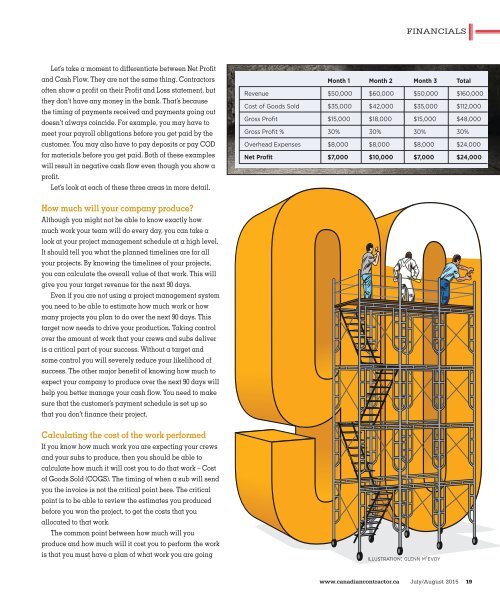Canadian Contractor - July-August 2015
You also want an ePaper? Increase the reach of your titles
YUMPU automatically turns print PDFs into web optimized ePapers that Google loves.
FINANCIALS<br />
Let’s take a moment to differentiate between Net Profit<br />
and Cash Flow. They are not the same thing. <strong>Contractor</strong>s<br />
often show a profit on their Profit and Loss statement, but<br />
they don’t have any money in the bank. That’s because<br />
the timing of payments received and payments going out<br />
doesn’t always coincide. For example, you may have to<br />
meet your payroll obligations before you get paid by the<br />
customer. You may also have to pay deposits or pay COD<br />
for materials before you get paid. Both of these examples<br />
will result in negative cash flow even though you show a<br />
profit.<br />
Let’s look at each of these three areas in more detail.<br />
Month 1 Month 2 Month 3 Total<br />
Revenue $50,000 $60,000 $50,000 $160,000<br />
Cost of Goods Sold $35,000 $42,000 $35,000 $112,000<br />
Gross Profit $15,000 $18,000 $15,000 $48,000<br />
Gross Profit % 30% 30% 30% 30%<br />
Overhead Expenses $8,000 $8,000 $8,000 $24,000<br />
Net Profit $7,000 $10,000 $7,000 $24,000<br />
How much will your company produce?<br />
Although you might not be able to know exactly how<br />
much work your team will do every day, you can take a<br />
look at your project management schedule at a high level.<br />
It should tell you what the planned timelines are for all<br />
your projects. By knowing the timelines of your projects,<br />
you can calculate the overall value of that work. This will<br />
give you your target revenue for the next 90 days.<br />
Even if you are not using a project management system<br />
you need to be able to estimate how much work or how<br />
many projects you plan to do over the next 90 days. This<br />
target now needs to drive your production. Taking control<br />
over the amount of work that your crews and subs deliver<br />
is a critical part of your success. Without a target and<br />
some control you will severely reduce your likelihood of<br />
success. The other major benefit of knowing how much to<br />
expect your company to produce over the next 90 days will<br />
help you better manage your cash flow. You need to make<br />
sure that the customer’s payment schedule is set up so<br />
that you don’t finance their project.<br />
Calculating the cost of the work performed<br />
If you know how much work you are expecting your crews<br />
and your subs to produce, then you should be able to<br />
calculate how much it will cost you to do that work – Cost<br />
of Goods Sold (COGS). The timing of when a sub will send<br />
you the invoice is not the critical point here. The critical<br />
point is to be able to review the estimates you produced<br />
before you won the project, to get the costs that you<br />
allocated to that work.<br />
The common point between how much will you<br />
produce and how much will it cost you to perform the work<br />
is that you must have a plan of what work you are going<br />
ILLUSTRATION: GLENN M C EVOY<br />
www.canadiancontractor.ca <strong>July</strong>/<strong>August</strong> <strong>2015</strong> 19

















